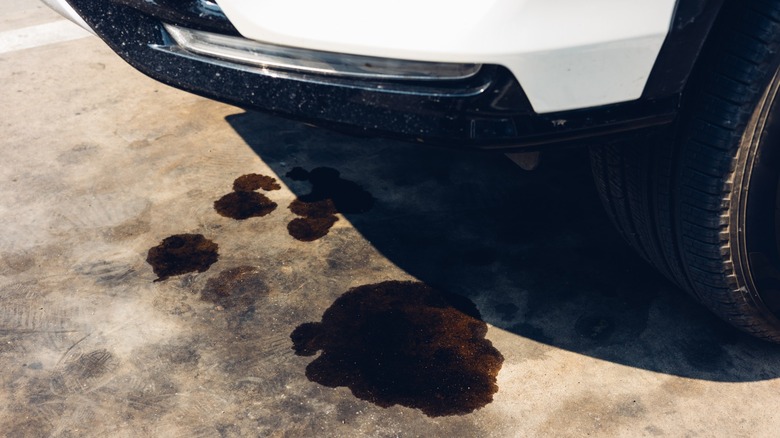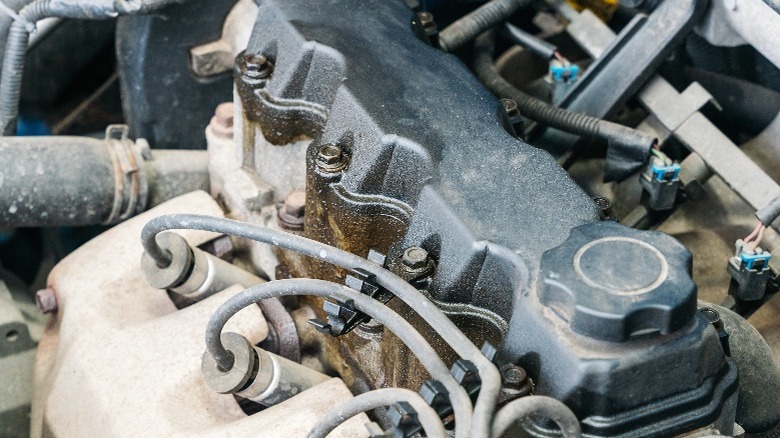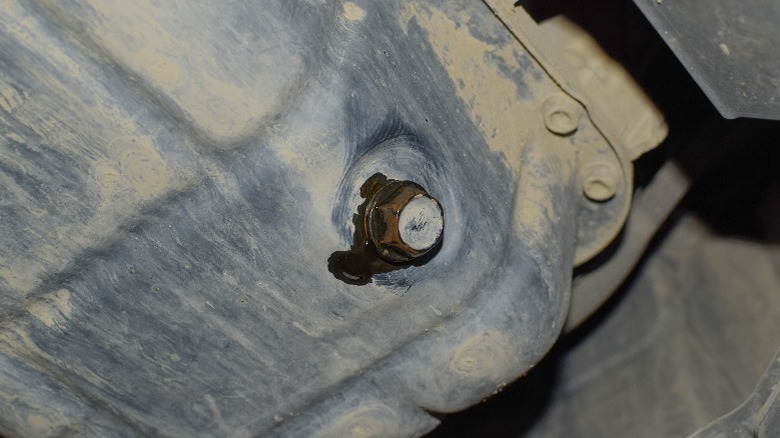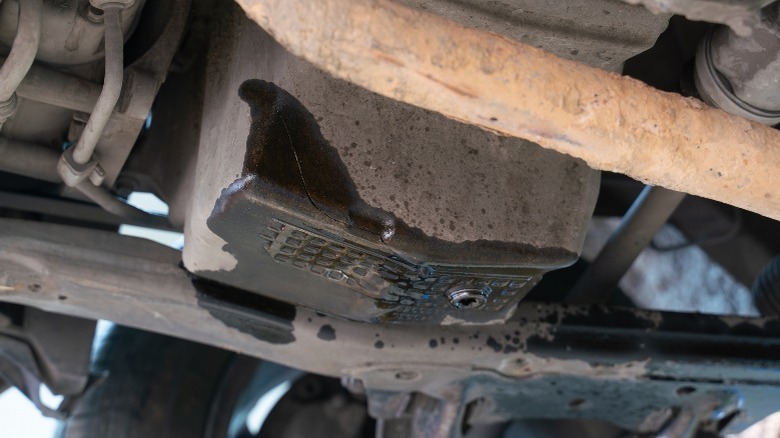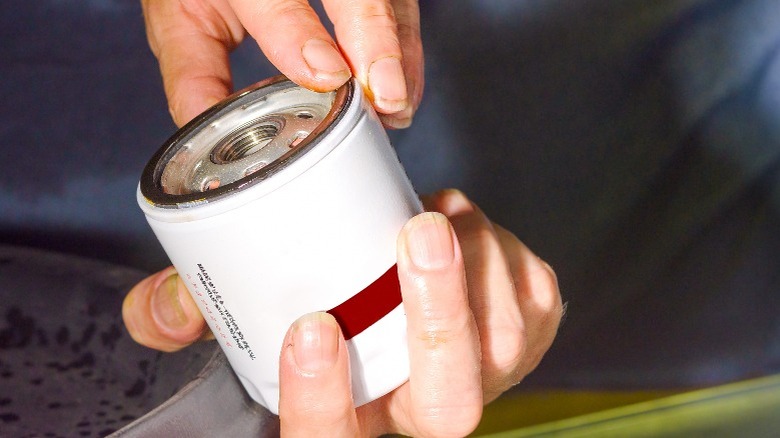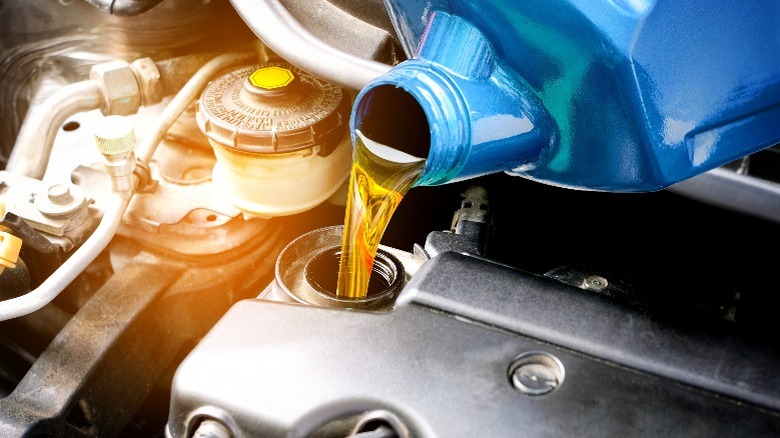5 Common Reasons Your Car's Engine Is Leaking Oil
Unless you drive a fully electric vehicle, motor oil is an absolutely essential component for your car. Oil is the lifeblood of your vehicle's engine. It provides lubrication for all of the engine's internal moving parts, prevents friction buildup, and serves as a heat sink by absorbing excess engine heat and carrying it away from sensitive components. Because of its many jobs and the extreme conditions to which it's subject, motor oil decays quickly inside the engine system. Most drivers should replace their oil every 3,000 to 7,500 miles, depending on their car. Doing so is by far one of the most accessible and affordable forms of vehicle maintenance you can perform. Oil changes go a long way toward protecting your car and ensuring your engine lasts for many years.
However, performing regular oil changes doesn't guarantee that your vehicle will never develop problems. Oil leaks, in particular, are a relatively common issue for car owners. They can occur even if you change your oil religiously. In fact, many oil leaks result from inexperienced drivers changing their oil incorrectly. Other common causes of oil leaks include things like worn-out valve cover gaskets and oil pan damage. No one likes to see a puddle of oil beneath their vehicle or a thick, greasy buildup in the engine bay. So, to help you avoid oil leaks and understand their most frequent causes, here are five common reasons your car's engine leaks oil.
Damaged valve cover gasket
By far, one of the most common causes of an oil leak is a damaged valve cover gasket. These are the rubber seals that sit between your engine's cylinder head and the cover that protects the valve train's upper components. The gasket is responsible for containing oil and stopping leaks, preventing debris or dust from entering the cylinder head, and forming a seal between the engine and valve cover.
Valve cover gaskets are designed to be highly durable and long-lasting. However, they are also subject to wear and tear over time. Valve cover gaskets can become damaged due to excessive heat, improper installation, or age. Typically, there isn't a set replacement interval for valve cover gaskets — you don't usually have to replace them unless they're leaking or otherwise damaged. However, if your valve cover gasket is leaking, you should replace it as soon as possible. The most common symptoms of a leaking gasket include damp, greasy spots around the upper engine, oil dripping down the side or back of the motor, and puddles of oil on the ground. A minor valve cover gasket leak will likely only result in a dirty engine bay, while a severe leak can cause catastrophic oil loss.
If you need to replace your valve cover gasket, don't worry. It's a relatively simple and straightforward procedure. A mechanic should be able to do the replacement in about an hour, depending on the car. But if you choose to replace the gasket yourself, remember to properly torque your valve cover bolts and follow the tightening pattern provided by your vehicle's manufacturer. Doing so can prevent future valve cover gasket problems.
Loose oil drain plug
An oil change is an absolutely essential form of vehicle maintenance. But like all maintenance or repair projects, it's critical that you follow the proper procedure and perform the steps correctly. Incorrectly changing your oil can be worse than not replacing it at all. That's not to say that oil changes are overly complex or difficult, even for novices. However, we can't stress enough the importance of doing the job right. That means following the instructions provided by your car's manufacturer regarding things like engine oil capacity and type, drain plug torque, and oil filter installation.
A lot of people disregard drain plug torque specifications when changing their oil. While that may be okay for seasoned veterans and automotive pros, most casual DIYers and car novices should follow the torque specs to a tee. If you install the drain plug too loosely, it may fall out due to vibrations while driving. If that occurs, your vehicle will quickly and disastrously lose nearly all of its oil, resulting in a potentially seized engine and thousands of dollars in damage. Even if the plug doesn't fall out, it may allow oil to seep out of the drain pan if it's installed too loosely. Alternatively, if you install the drain plug too tightly, you might damage the drain pan or strip its threads. These issues can also cause leaks and other damage. For example, if the plug is too tight, a mechanic may have to drill it out, resulting in the need for an entirely new drain pan and expensive repair work.
Oil pan damage
Your car's engine oil pan is basically a storage facility or reservoir for motor oil. After flowing through the engine, the oil is extremely hot. It travels to the oil pan, where it sheds excess heat before the oil pump forces it through a filter and back into the engine. You don't normally have to replace the oil pan as part of routine maintenance. However, due to its location on the bottom of the vehicle, the oil pan is highly vulnerable to damage caused by rocks, road debris, and potholes. Furthermore, oil pan gaskets can degrade over time, similar to valve cover gaskets. It's not uncommon for faulty oil pan gaskets to cause leaks, even if the pan itself is in excellent condition.
If the pan becomes damaged, it can quickly cause devastating oil leaks. These leaks are usually easily noticeable due to the large puddles of oil they tend to leave on the ground. If your oil pan becomes damaged and leads to an oil leak, you'll need to replace it as soon as possible, and you should avoid driving your car until you fix the problem. Oil pan replacement is fairly easy and straightforward, but it can be pricey due to the cost of replacement parts. Like the valve cover gasket, you'll need to follow the proper torque pattern and specs if you choose to install a new oil pan yourself. Otherwise, a mechanic should be able to complete the repair in one to three hours, depending on your vehicle.
Improperly installed oil filter
Just like your oil drain plug, it's also vital that you install the oil filter correctly when performing an oil change. Most oil filters have torque specifications. However, you really can't use a torque wrench on them due to their size. Instead, there are a few steps to follow when installing an oil filter to prevent leaks and other damage. First, you need to apply a light layer of oil to the filter's gasket. Doing so prevents the gasket from tearing during installation and also helps keep the filter from seizing to its housing, making it easier to remove during your next oil change. Second, when you install the filter, screw it on until it feels snug, and then turn it one-quarter to one-half turn more. After that, stop. Any tighter, and you risk damaging the filter or its housing.
If you install your oil filter too loosely, you're likely to develop leaks around the housing. Like drain pan damage, oil filter leaks typically cause puddles of oil beneath the car. If you have an oil leak due to an improperly installed oil filter, the fix is simple — as long as your engine hasn't been without adequate oil for too long. All you'll need to do is replace the oil filter with a new one of the correct type and install it properly. Then, top off any oil you lost due to the leak. That said, if your car has been losing oil for an extended period, your engine may have developed more extensive damage. Any time you experience an oil leak, it's a good idea to visit a mechanic for an inspection and to determine the true extent of any damage.
Too much oil in the engine
Every internal combustion engine has a specified oil capacity — the amount of oil the engine is capable of storing at one time. Too little oil can result in inadequate lubrication and overheating. However, too much oil is also dangerous for your engine. Adding too much oil to your car's engine can result in blown seals, spark plug damage, clogged valves, and gasket leaks. The marks on your vehicle's oil dipstick are there for a reason. Use them any time you change your oil to ensure that the level is within the appropriate range. If you accidentally add too much oil to your engine, you'll have to drain some of it back out again. Yes, that's a pain in the butt, but it's better than paying for costly repairs after you blow an engine seal or flood your spark plugs.
There are a couple of tips you should follow to help you avoid overfilling your engine with oil. First, check your car's oil capacity before starting your oil change. If your vehicle has an oil capacity of four quarts, start off by adding 3.5 quarts of oil. Then, check the level and add more oil incrementally until you reach the proper range. Finally, it's worth remembering that oil capacities don't always factor in the oil filter. An oil filter will generally hold around a quarter to one quart of oil. After you replace your filter and fill the engine with clean oil, start your car and let it run for about 30 seconds. This allows the oil to enter the new filter. Then, recheck your oil level to ensure that it's within the correct range.
